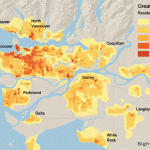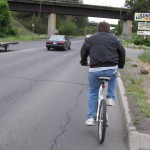Search Results
-
Sprawl and Smart Growth in Greater Vancouver, BC
Just released: Sightline’s analysis of smart growth trends in Greater Vancouver, BC. We crunched Canadian census data from 1991 through 2006, looking in particular at residential development trends in BC’s lower mainland. The good news: pedestrian-oriented development is going gangbusters in the city of Vancouver itself, along with a few of the municipalities just outside the city. Given the economic burden that’s being created by rising gas prices—let alone the...Read more » -
Sprawl and Smart Growth in Selected Northwest Cities
Sightline Institute’s reports on sprawl and smart growth in several Northwest cities analyze how each city did at curbing sprawl and developing efficiently, starting with the period of the 1990s.Read more » -
Sprawl and Smart Growth in Greater Vancouver, BC
Vancouver, BC’s smart-growth leadership has slipped in recent years. This time-lapse map shows the growing sprawl.Read more » -
Sprawl Killing Puget Sound
Big three-day series in the Seattle Times on Puget Sound launches today. Day one is great. If you’re time-pressed, here it is, shorter: Sprawl is the real killer of the sound. Cities—complete, compact communities—are the solution. Fortuitously, that’s exactly what Cascadia needs for jobs, health, energy independence, and climate security too.Read more » -
Gas Prices Up, Sprawl Down
Years ago, I heard from an economist friend about research showing that urban rents rose with oil prices in the 1970s, while suburban ones fell. Ultimately, land values reflect the shifts in the values of many things. So rising fuel prices would be expected to have the effect of making fuel-guzzling neighborhoods less desirable and fuel-sipping ones more desirable. We’re starting to see that pattern now. Today’s top news story...Read more » -
Sprawl Is Hot
UPDATE 6/13/07:John Norquist gets the issue exactly right in a recent-ish op-ed. Here’s the crux: In the next 30 years, our country will build 70 million new dwellings somewhere. With urban life emerging as a market favorite, it’s looking more as if building a good portion of them in livable, walkable traditional neighborhoods is one of the most convenient – and effective – remedies for the inconvenient truth. In some...Read more » -
Sprawl and Health Connections
Emerging research is discovering that the design and layout of your neighborhood can affect your health. People who live in low-density, sprawling residential areas–where houses are far from stores and jobs–tend to drive more, and walk less, than people who live in more compact neighborhoods with a mixture of stores, services, and homes.Read more » -
The Research: Studies on Health and Sprawl
Sources of information about how community design and traffic affect health.Read more » -
Sprawl of Boise
In NEW’s seven-city study of Northwest cities and sprawl—part of our Cascadia Scorecard project—Boise ranked worst. What’s heartening is that many Boise community leaders, members of the media, and advocates in Idaho are bent on doing something about it. An Idaho Statesman editorial this weekend—which cited our energy and sprawl research extensively—laments the city’s smart-growth record and notes the strong connection between Idaho’s sprawl and energy habits. (Idaho also consumes...Read more » -
Sprawl, Health, Place: Notes from Buckley, WA
I recently attended a conference in Seattle for promoting physical activity in urban environments. Alliances between the public health and planning communities are moving out of academia and are being forged on the ground. And it was encouraging to see that what we’re trying to do in my small town in Washington with respect to walkability is what you’re supposed to be doing. But walkability by itself is a tough...Read more »





